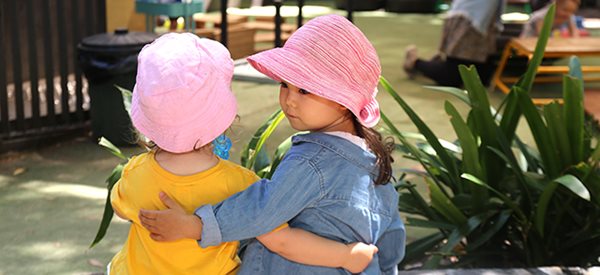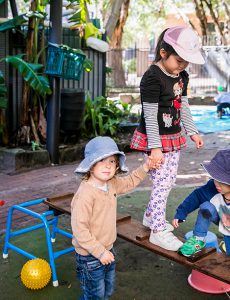Kindness may be seen as a kind of old-fashioned virtue, but in a world where bullying and mental health issues abound, it’s more relevant than ever. It doesn’t matter what age you are, an act of kindness can put a rainbow splash on the dullest of days.
Harvard psychologist Richard Weissbourd says:
Children are not born simply good or bad and we should never give up on them. They need adults who will help them become caring, respectful, and responsible for their communities at every stage of their childhood.
So how can we promote kindness among children?
The word kindness is only mentioned once in The Early Years Learning Framework – it’s in Outcome 2: Children are connected with and contribute to their world
'Children become aware of fairnes [when they] develop the ability to recognise unfairness and bias and the capacity to act with compassion and kindness.'
However, most of the elements in Outcome 3: Children have a strong sense of wellbeing, also draw out a range of skills and behaviours that you could say are about ‘being kind’. These include: celebrating the achievements of others; cooperate and work collaboratively; manage their emotions in ways that reflect the feelings and needs of others; increasing awareness of the needs and rights of others.

5 tips for promoting kindness amongst children
Psychologist Richard Weissbourd leads a program at Harvard called ‘Making Caring Common’ – he says:
Our vision is a world in which children learn to care about others and the common good, treat people well day to day, come to understand and seek fairness and justice, and do what is right even at times at a cost to themselves.
The practical tips of the program are summarised in an article in the Washington Post and involve:
- Make caring for others a priority – a study by Weissbourd found that About 80 percent of the youth surveyed said their parents were more concerned with their achievement or happiness than whether they cared for others.
- Provide opportunities to help children practice caring and gratitude – the best way to learn gratitude is to practice it daily.
- Expand childrens’ ‘circle of concern’ – help them to move beyond caring just about their immediate family and friends and learn to care about children who are new or different.
- Be a strong role model and mentor – children learn more from what we do than what we say.
- Guide children in managing destructive feelings – often children find it difficult to care about the feelings of others if they are overwhelmed by feelings of anger, shame, envy, guilt or other negative emotions.
Kindness and compassion – the antidote to bullying
 Provide opportunities to help children practice caring and gratitude
Provide opportunities to help children practice caring and gratitude
There is also a wealth of helpful information about how to develop kindness and compassion in young children in anti-bullying resources.
Bullying is a serious problem, according to Dr Ken Rigby, Adjunct Professor, University of South Australia and member of the National Centre Against Bullying. He writes that one in five children are bullied in Australian schools every few weeks, yet two thirds of bullied children don’t seek help from a trusted adult.
Thankfully, The Australian Government is now investing in early intervention programs to support parents and educators to stop bullying behaviour developing before children start school.
The Federal Government’s Bullying. No Way! Website explains that teaching young children social skills prevents bullying later. The site provides ideas for parents, educators and carers to guide children to develop positive interactions which will benefit them their whole life.
Educators can:
- Be a positive role model of what you would like the children to do
- Build up a class ‘language’ of feelings and pro-social behaviour by naming social and emotional skills and referring to them regularly
- Use naturally occurring activities to talk about social and emotional skills
- Integrate social and emotional skills into the daily curriculum
- Teach the behaviour that is expected in class explicitly, in the playground, in small groups, at transition times during the day, etc.
- Ensure children know the consequences for behaviour that is inappropriate and ensure these consequences are applied consistently
- Teach social problem solving skills explicitly and build up a class language of social problem-solving
- Use social conflict and problems, like fights, to talk about and teach social problem solving skills
- Provide additional help to those children who need support to learn social, emotional, behavioural and social problem solving skills
- Use a range of resources: personal stories, art, drama, discussion of current events, movies, photos, books and technology to explore positive social behaviour
- Ensure you use only evidence-based and appropriate resources, for example, consider using a specific social-emotional learning (SEL) program
This 2 minute video is a great way to open a discussion about kindness with preschoolers.
It shows young children treating each other kindly in a variety of ways. Educators could introduce the video by asking children to look for all the ways that children are getting along together, sharing and being kind.
Kindness resources
Some cool resources for early childhood educators from the Australian Bullying. No Way! Website:
Try the 16 Days of Kindness challenge from the Australian Kindness Movement
Further reading
About CELA
Community Early Learning Australia is a not for profit organisation with a focus on amplifying the value of early learning for every child across Australia - representing our members and uniting our sector as a force for quality education and care.